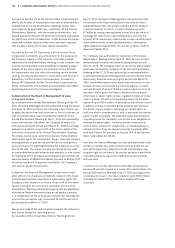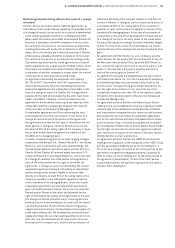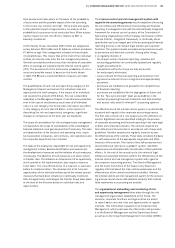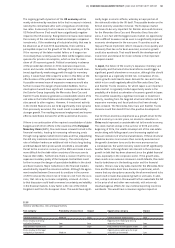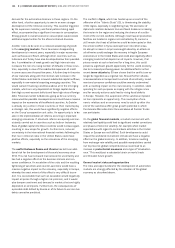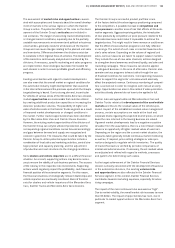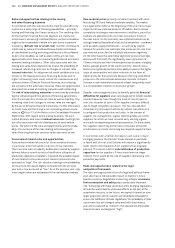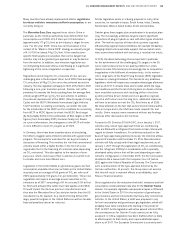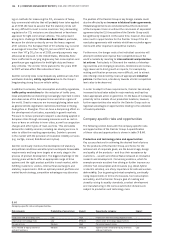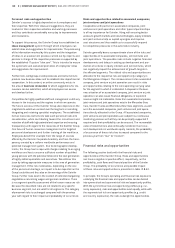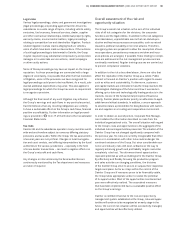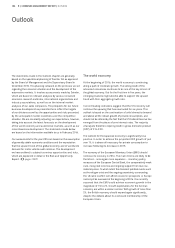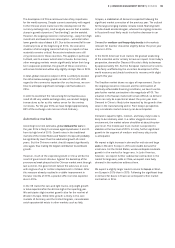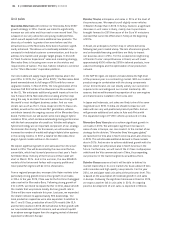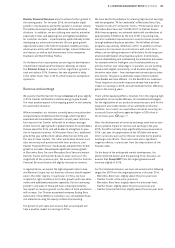Mercedes 2015 Annual Report Download - page 139
Download and view the complete annual report
Please find page 139 of the 2015 Mercedes annual report below. You can navigate through the pages in the report by either clicking on the pages listed below, or by using the keyword search tool below to find specific information within the annual report.
146 B | COMBINED MANAGEMENT REPORT | RISK AND OPPORTUNITY REPORT
ing on methods for measuring the CO2 emissions of heavy-
duty commercial vehicles that will probably have to be applied
as of 2018. We have to assume that the statutory limits will
be very difficult to meet in some countries. Very demanding
regulations for CO2 emissions are also planned or have been
approved for light commercial vehicles. This will present
a long-term challenge for Mercedes-Benz Vans in particular,
because the division primarily serves the heavy segment
of N1 vehicles. The European fleet of N1 vehicles may not emit
an average of more than 175 g CO2/km as of 2017 and not
more than 147 g CO2/km as of 2020; penalty payments may
otherwise be imposed. In the United States, Mercedes-Benz
Vans is affected to varying degrees by fuel-consumption and
greenhouse-gas regulations for both light-duty and heavy-
duty vehicles. The stricter limits planned for the years 2021
to 2027 will also affect Mercedes-Benz Vans.
Daimler currently does not anticipate any additional risks from
worldwide statutory safety regulations due to the Group’s
longstanding strong focus on vehicle safety.
In addition to emission, fuel consumption and safety regulations,
traffic-policy restrictions for the reduction of traffic jams,
noise and pollution are becoming increasingly important in cities
and urban areas of the European Union and other regions of
the world. Drastic measures are increasingly being taken such
as general vehicle-registration restrictions like those in Beijing,
Guangzhou or Shanghai. This can have a dampening effect on
the development of unit sales, especially in growth markets.
Pressure to reduce personal transport is also being applied in
European cities through increasing measures such as restric-
tions or bans on vehicles in inner cities, as well as congestion
charges and other types of road-use fees. This stimulates
demand for mobility services, including car sharing services. In
order to utilize the resulting opportunities, Daimler is present
in the market with the provision of innovative mobility services
(e.g. car2go, moovel, RideScout and mytaxi).
Daimler continually monitors the development of statutory
and political conditions and attempts to anticipate foreseeable
requirements and long-term targets at an early stage in the
process of product development. The biggest challenge in the
coming years will be to offer an appropriate range of drive
systems and the right product portfolio in each market, while
fulfilling customers’ wishes, internal financial targets and
statutory requirements. With an optimal product portfolio and
market-launch strategy, competitive advantages may also arise.
The position of the Daimler Group in key foreign markets could
also be affected by an increase in bilateral trade agreements.
If bilateral agreements are concluded without the involvement
of the European Union or without the conclusion of equivalent
agreements by the EU, the position of the Daimler Group could
be significantly impacted. At the same time, however, this could
also result in opportunities for the Daimler Group if the EU
concludes agreements with markets which have no similar agree-
ments with other important competitive markets.
Furthermore, the danger exists that individual countries will
attempt to defend and improve their competitiveness in the
world’s markets by resorting to interventionist and protection-
ist actions. Particularly in China and the markets of develop-
ing countries and emerging economies, tendencies are increas-
ingly observed to limit growth in imports, for example by
making certification processes more difficult, and to attract
direct foreign investment by means of appropriate industrial
policies. Furthermore, a tendency towards stricter competition
law is also to be observed.
In order to adapt to these requirements, Daimler has already
increased its local value added in major markets, and has thus
taken appropriate action in good time. On the basis of increasing
proximity to the markets of our production locations, however,
further opportunities also exist for the Daimler Group such as
logistical advantages or opportunities relating to the utilization
of market potentials.
Company-specific risks and opportunities
The following section deals with the company-specific risks
and opportunities of the Daimler Group. A quantification
of these risks and opportunities is shown in table
B.60.
Production and technology risks and opportunities
Key success factors for achieving the desired level of prices
for the products of the Daimler Group, and hence for the
achievement of corporate goals, are the brand image, design
and quality of the products – and thus their acceptance by
customers – as well as technical features based on innovative
research and development. Convincing solutions, which for
example promote accident-free driving or further improve our
vehicles’ fuel consumption and emissions (e.g. diesel-hybrid
or electric vehicles), are of key importance for safe and sustain-
able mobility. Due to growing technical complexity, continually
rising requirements in terms of emissions, fuel consumption
and safety, and the Daimler Group’s goal of meeting and
steadily raising its quality standards, product development
and manufacturing in the various automotive divisions are
subject to production and technology risks.
Company-specific risks and opportunities
Risk category Probability of occurrence Impact Opportunity category Impact
Production and technology risks Low High Production and technology opportunities –
Information technology risks Low Medium Information technology opportunities –
Personnel risks Medium High Personnel opportunities –
Risks related to equity interests
and joint ventures
Medium Medium Opportunities related to equity interests
and joint ventures
Low
B.60


